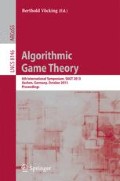Abstract
Network coordination games (NCGs) have recently received a lot of attention since they model several kinds of interaction problems in social networks. However, the performance of these games at equilibrium may be very bad. This motivates the adoption of mechanisms for inducing a socially optimal state. Many settings are naturally dynamical and thus we believe it is worth to consider the design of incentive compatible best-response mechanisms (Nisan, Schapira, Valiant, Zohar, 2011) for NCGs. Specifically, we would like to assign to players special fees in order to induce the optimum profile of an NCG. Moreover, we would like the mechanism to be budget-balanced, i.e., implementable with no cost.
We show that a budget-balanced and incentive compatible best- response mechanism for inducing the optimal profile of a two-strategy NCG always exists. Moreover, for such a mechanism, we investigate other properties inspired by envy-freeness, collusion-resistance and fairness.
Access this chapter
Tax calculation will be finalised at checkout
Purchases are for personal use only
Preview
Unable to display preview. Download preview PDF.
References
Jackson, M.O.: Social and Economic Networks. Princeton University Press, Princeton (2008)
Nowak, M.A.: Evolutionary Dynamics: Exploring the Equations of Life. Harvard University Press (2006)
Galam, S., Walliser, B.: Ising model versus normal form game. Physica A: Statistical Mechanics and its Applications 389(3), 481–489 (2010)
Kempe, D., Kleinberg, J.M., Tardos, É.: Influential nodes in a diffusion model for social networks. In: Caires, L., Italiano, G.F., Monteiro, L., Palamidessi, C., Yung, M. (eds.) ICALP 2005. LNCS, vol. 3580, pp. 1127–1138. Springer, Heidelberg (2005)
Young, H.P.: The diffusion of innovations in social networks. Economics Working Paper Archive number 437, Johns Hopkins University, Department of Economics (2000)
Ferraioli, D., Goldberg, P.W., Ventre, C.: Decentralized dynamics for finite opinion games. In: Serna, M. (ed.) SAGT 2012. LNCS, vol. 7615, pp. 144–155. Springer, Heidelberg (2012)
Koutsoupias, E., Papadimitriou, C.: Worst-case equilibria. Computer Science Review 3(2), 65–69 (2009)
Beckmann, M., McGuire, C., Winsten, C.: Studies in the economics of transportation. Yale University Press (1959)
Cole, R., Dodis, Y., Roughgarden, T.: Pricing network edges for heterogeneous selfish users. In: Proceedings of the Thirty-Fifth Annual ACM Symposium on Theory of Computing, STOC 2003, pp. 521–530. ACM (2003)
Korilis, Y., Lazar, A., Orda, A.: Achieving network optima using stackelberg routing strategies. IEEE/ACM Transactions on Networking 5(1), 161–173 (1997)
Monderer, D., Tennenholtz, M.: k-implementation. In: ACM Conference on Electronic Commerce, pp. 19–28 (2003)
Christodoulou, G., Koutsoupias, E., Nanavati, A.: Coordination mechanisms. Theor. Comput. Sci. 410(36), 3327–3336 (2009)
Nisan, N., Schapira, M., Valiant, G., Zohar, A.: Best-response mechanisms. In: Innovations in Computer Science (ICS), pp. 155–165 (2011)
Escoffier, B., Ferraioli, D., Gourvès, L., Moretti, S.: Designing frugal best-response mechanisms for social network coordination games, http://www.lamsade.dauphine.fr/~ferraioli/papers/paris_paper.pdf
Shapley, L.S.: A value for n-person games. Contributions to the Theory of Games 2, 307–317 (1953)
Biedl, T.C., Chan, T.M., Ganjali, Y., Hajiaghayi, M.T., Wood, D.R.: Balanced vertex-orderings of graphs. Discrete Applied Mathematics 148(1), 27–48 (2005)
Author information
Authors and Affiliations
Editor information
Editors and Affiliations
Rights and permissions
Copyright information
© 2013 Springer-Verlag Berlin Heidelberg
About this paper
Cite this paper
Escoffier, B., Ferraioli, D., Gourvès, L., Moretti, S. (2013). Designing Budget-Balanced Best-Response Mechanisms for Network Coordination Games. In: Vöcking, B. (eds) Algorithmic Game Theory. SAGT 2013. Lecture Notes in Computer Science, vol 8146. Springer, Berlin, Heidelberg. https://doi.org/10.1007/978-3-642-41392-6_18
Download citation
DOI: https://doi.org/10.1007/978-3-642-41392-6_18
Publisher Name: Springer, Berlin, Heidelberg
Print ISBN: 978-3-642-41391-9
Online ISBN: 978-3-642-41392-6
eBook Packages: Computer ScienceComputer Science (R0)

